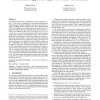27 search results - page 3 / 6 » Defending Against Attacks on Main Memory Persistence |
COMCOM
2006
13 years 5 months ago
2006
To defend against multi-step intrusions in high-speed networks, efficient algorithms are needed to correlate isolated alerts into attack scenarios. Existing correlation methods us...
HPCA
2008
IEEE
14 years 5 months ago
2008
IEEE
Multiprocessor computer systems are currently widely used in commercial settings to run critical applications. These applications often operate on sensitive data such as customer ...
IJDE
2006
13 years 5 months ago
2006
Rootkits are malicious programs that silently subvert an operating system to hide an intruder's activities. Although there are a number of tools designed to detect rootkits, ...
DIMVA
2008
13 years 6 months ago
2008
Over the past several years, US-CERT advisories, as well as most critical updates from software vendors, have been due to memory corruption vulnerabilities such as buffer overflo...
ASPLOS
2012
ACM
12 years 1 months ago
2012
ACM
Virtualization has become a standard part of many computer systems. A key part of virtualization is the all-powerful hypervisor which manages the physical platform and can access ...

